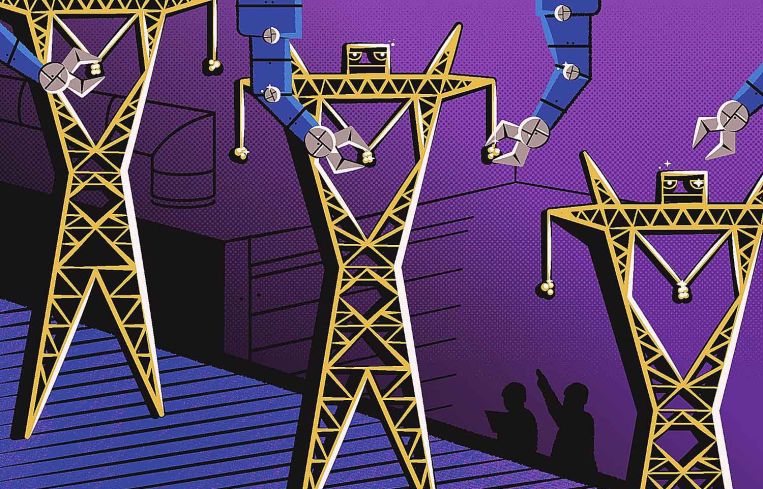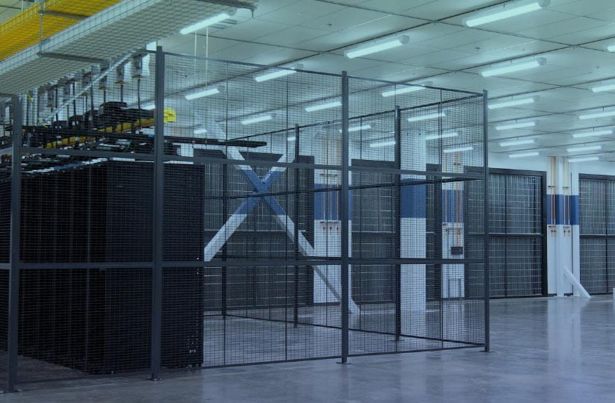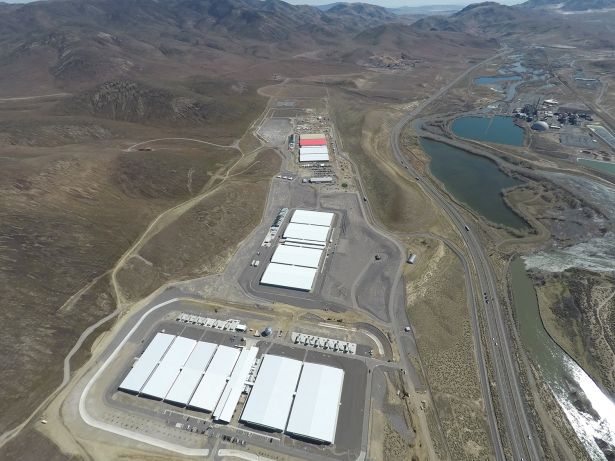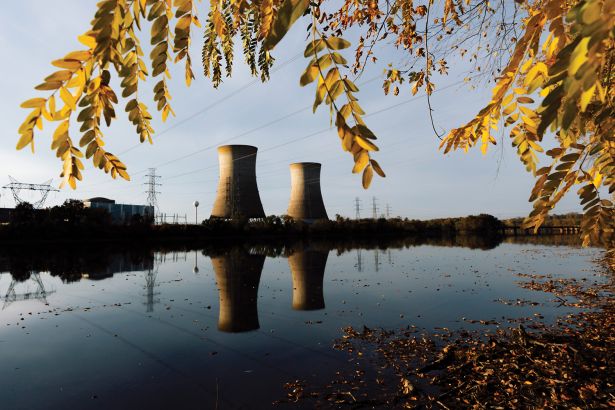GenAI + Data Center Boom = Electrical Grid Crisis
Investors, analysts and operators fear ‘a power civil war’ as few short-term solutions emerge
By Brian Pascus February 19, 2025 6:30 am
reprints
On Jan. 21, one day after being inaugurated as the 47th U.S. president, Donald Trump stood outside the Roosevelt Room in the White House with Oracle’s Larry Ellison, OpenAI’s Sam Altman and SoftBank’s Masayoshi Son to announce a $500 billion private sector investment in the construction of 20 new data centers, collectively spanning 10 million square feet and meant to power generative artificial intelligence (GenAI) across the entire country.
In a bit of Trumpian bluster, the new president said the U.S. would secure the electricity needed for the data centers “very easily.”
The news further reinforced a clear futuristic truth about the way we live today: As GenAI technology comes online, and cloud computing becomes the collective hard drive of humanity, the real estate assets that power this brave new future — data centers — are becoming the veritable neural networks of American society.
However, there’s only one thing Trump and the tech barons forgot to mention: The electricity required to power these assets is precarious at best. After three decades of capital markets investment into data center construction, commercial real estate experts are gradually waking up to the seriousness of the electricity supply challenge and how to solve it.
“There’s no doubt we’re seeing strains on the grid from a couple different levels, and one is the ability to transmit power from the generation source to the data center,” said Carrington Brown, senior managing director at Affinius Capital. “If you look at the size of the industry, it’s growing 25 percent to 30 percent per year in terms of total power, but more generation and transmission capacity is needed to meet demand we’re seeing today and into the future.”
But the true elephant (or futuristic wild card) in the room is GenAI technology, which has rapidly increased data center power requirements, despite it being less than three years since ChatGPT came online in fall 2022. Several experts noted that data centers as an asset class have been around for decades — essentially evolving out of the old telecommunications industry — but the energy requirements from GenAI have precipitated an entirely new response that the existing data center industry simply isn’t prepared for.
Numbers tell the story: A new data center facility typically requires at least 1 gigawatt of power to operate indefinitely (its power capacity), which is the equivalent of the amount of power consumed by 800,000 homes over an entire year. Last year, U.S. data center absorption was tracked at 7,300 megawatts, a 29 percent increase in total U.S. inventory from 2023, according to Affinius Capital.
And consider this: 1 gigawatt equals 1,000 megawatts.
“Grid operators are really nervous. They have scheduled upgrades that need to happen, but they can’t keep up with the demand, so there’s this panic mode that’s happening right now,” said Tommy Zakrzewski, director of building engineering physics at HKS, an architecture and planning firm.
Wells Fargo has estimated that U.S. electricity demand could jump 20 percent by 2030, mostly because of data centers.
“We can’t keep up with the demand that’s happening, utilities can’t keep up with demand that’s expected, which keeps shifting, as the numbers keep doubling every month,” said Zakrzewski. “In the next five years, we’re quadrupling the amount of demand we need, so that poses some problems.”
The demand is coming from all corners, according to Alan C. Anderson, chair of law firm Polsinelli’s national energy practice group. Anderson noted that the power demands from data centers come from not only conventional internet use, cloud computing and cryptomining facilities, but now AI computing, as well.
Moreover, Anderson emphasized that the nation has increased its advanced manufacturing capabilities, mainly through the 2022 Inflation Reduction Act, even as it’s demanded more from the grid via electric vehicle usage, as well as the grid performance needed during severe weather events, such as when Phoenix saw 113 consecutive days above 100 degrees in 2024 — a modern record.
“We’re having a truly remarkable transition on the grid, and it’s more than just data centers,” said Anderson. “All items are hitting us from a demand perspective at the same time. Data centers are part of that, but they aren’t the only thing.”
And yet, data centers, particularly as GenAI applications multiply exponentially, are now the single most important element to the power supply conundrum. The latest AI processing technology can complete a complex computation task in seconds that previously took the world’s best computer 32 hours to perform, according to JLL.

“The chips of AI applications consume a tremendous amount of power, a lot more power than traditional chips running data centers from five to 15 years ago,” said Curt Holcomb, executive managing director of data center solutions at JLL. “And that’s where the big jump in electricity demand comes from: increasing cloud operations, these AI applications, and the power needed to run them.”
So as demand quadruples this decade, there’s no telling where the power needs will be by the 2030s, 2040s and 2050s, when GenAI will almost certainty factor into numerous aspects of our everyday lives.
And while it’s not the world’s sexiest topic, the U.S. electrical grid holds the key to present and future use of the technology that now runs the planet, so long as it maintains.
“We used to say the top three things we cared about were power, water fiber. And now it’s power, power, power,” said Nic Bustamante, chief technology office at Corscale DataCenters. “The AI component being added in the last couple of years has compounded it even more.”
Grid and bear it
The main reason why the data center power conundrum is so complex is due to the players involved: aging utility companies, innovative (but impatient) tech firms, and the biggest players in U.S. capital markets (who are fronting the money and demand a return).
“It’s hard to think of two industries less alike than big tech and utilities,” said Christopher Russo, vice president and co-head of energy at Charles River Associates, a data center advisory firm. “There’s nothing about the grid that’s designed to deliver 100 megawatts at a time. And tech, on the other hand, is an industry that moves fast.”
The grid is divided into three independent sections — an East Coast grid, a West Coast one and a Southern grid that’s largely powering Texas (seriously) — all of which are insulated from each other to prevent a national blackout. Within each zone are independent service providers, and within this diffuse network are independent utility operators with their own power plants. These utilities charge customers based on how much power they use, making data center owners and tenants a true golden goose for utility firms.
“New companies are building 500-megawatt data centers, but a lot of utilities that are connecting consumers are facing this challenge of ‘How do I add 80 gigawatts to my grid and serve these data centers?’” said Ayse Coskun, a professor of information systems engineering at Boston University. “All of these data centers, with the growth of AI, are causing unforeseen, really unprecedented demands on the grid.”
It’s one thing for data centers to stress the grid, but it’s quite another for them to fracture the fragile transmission system set in place for a world that never envisioned AI technology or cloud computing in the first place.
“In a lot of cases, the utilities do have the generation capacity to serve a lot for what’s been requested — so far — but the problem is in transmission,” said JLL’s Holcomb. “The existing transmission infrastructure isn’t adequate to get enough electrons from the germination source to areas the data center developers and hyperscalers want to build at. That’s the big holdup.”
Patrick Wilson, a portfolio manager for CenterSquare Investment Management’s real estate securities group, emphasized that the transmission dilemma is mainly a result of the big five hyperscalers — Google, Amazon, Meta, Microsoft and Apple — having initially built data centers in or near regions that consume the most power: Northern Virginia, Dallas-Fort Worth, California’s Santa Clara, greater Chicagoland. Now they must reckon with the fact that those regions are consuming too much electricity, irrespective of data centers.

“Power is too scarce in those markets, but what’s going to happen is they’ll go where there is power, so we’re seeing data centers built in Mount Pleasant, Wis., and Council Bluffs, Iowa, and New Albany, Ohio,” explained Wilson. “You’ll see the sites will just get further and further away from populations into more rural areas, where you get more land and they have a grid that has capacity to take them.”
The nation has always had an expansive, innovative grid across its different regions. Over the last century, the grid has undergone several upgrades to effectively distribute power, ranging from the construction of the hydroelectric Hoover Dam and the creation of the Tennessee Valley Authority to the birth of long-range transmission lines and smart-grid technology, such as wind turbines and solar energy.
But nothing has trained the grid for the demand coming from GenAI-reliant data centers, and very little is preparing the American consumer for the way data center power requirements will govern electricity supply.
In 2016, U.S. data center electricity absorption was 792 megawatts nationally, and was below 2,900 megawatts as recently as 2020. Fast forward a bit: Data center absorption ran past 6,000 megawatts in 2023 and 7,300 in 2024, according to Affinius Capital Research. God knows what 2025 will bring.
“Do I think data centers can take down more power than the grid can provide? Yes, 100 percent,” said Wilson, who added that data centers currently consume 4 percent of all power in the U.S. today, but that’s expected to jump as high as 12 percent by 2030.
Considering that supply and demand is the iron law of economics, the question becomes: Who will pay for that increased power demand from an aging grid with only so much electric capacity?
“The true answer is that there’s a residential price and there’s a data center price,” explained Wilson. “Heretofore, the line is that it hasn’t had an impact on residential pricing. But if we continue to go at this pace, many people project it’s going to be very difficult for it not to [affect residents].”
Zakrzewski predicted that not only will the demand by Gen AI data centers cause environmental damage and blackouts, but many utilities have also bitten off more than they can chew in terms of the contracts they signed to deliver power to the hyperscalers of AI and cloud computing.
“You have this entity that’s slowly taking over the grid, and the grid operators don’t have a solution to manage its demand,” he said. “Who pays for the problem? History tells us it’s the ratepayer. For better reliability that’s being caused by someone else, that resident will have to fork over more money to create this new generation capacity in a very short period of time.”
Nuclear option
Besides of the generational level of grid management that needs to take place almost immediately, tens of billions of dollars must be invested in power generation to fulfill current demand.
Affinius’ Brown noted that the upgrades will require partnerships among sponsors, tenants, investors and utilities. Unfortunately, investors like Brown might balk at the costs. Basic generation upgrades for a utility company to deliver power can cost as much as $80 million per data center site, with transmission substantiation improvements as high as $60 million per site, he said.
“For data center sites spending that type of money, without commitments from a user, [it] certainly starts to be a different level of risk than we’ve seen in the past,” explained Brown. “Scale starts to matter. If you’re stating that it costs $100 million for network upgrades for 50 megawatts of capacity, then that probably won’t make sense in any circumstance.”
Moreover, the biggest risk for data center investment pivots on the power delivery delays and the prolonged process required to upgrade transmission networks. Today, many data center land sites face five years until power can be brought online, even after capital has already been allocated.
“You’re delivering into the point in a cycle that you have less visibility into. That in itself is a risk,” said Brown. “[With other assets] I’m starting a building today, delivering in 18 months, and we’re talking five or six years from now. How do you price those leases? How do you price that risk?”
If the investment into grid upgrades and data center development won’t come from private capital, it is likely to be found by the hyperscalers themselves, particularly through investment in nuclear energy.
To wit, last year Microsoft invested $3 billion into restarting Pennsylvania’s Three Mile Island nuclear plant (which closed in large part due to the worst nuclear accident in U.S. history) to power its data center needs. Also last year, California-based nuclear energy firm Kairos Power joined Google to fuel its data centers. Dow and X-energy have a 2023 agreement to power one of Dow’s U.S. Gulf Coast sites. And Amazon last year signed agreements to develop three nuclear-powered data centers.
Utilities are also prepared to let these private companies source their own energy generation via microgrids built by the hyperscalers themselves. These microgrids would not be directly connected to the utility, but would still utilize its transmission infrastructure, according to Polsinelli’s Anderson.

“That would require regulatory change, but that’s the most beneficial and groundbreaking change we’ll see in the new future,” said Anderson. “If you let these great companies make deals with renewable companies, where they can locate a facility in proximity, but not directly connected, we can solve this [energy] backlog they’ll face.”
Moreover, hyperscalers, elected officials and utility firms are leaning into renewable and carbon-free energy sources — wind, solar, hydropower, geothermal and now nuclear energy — to answer the data center power demand.
“The big picture is that it’s forcing the modernization of the power grid. The grid hasn’t had much investment in some time, but the new power demands are forcing investment in the power grid and creating efficiencies,” said Benjamin Wobschall, executive vice president of CBRE’s data center capital markets team. “The fact that investments are being made into the power grid should benefit everyone from the standpoint of grid reliability.”
So there you have it — there’s nothing to worry about. We’ll just invest and innovate our way out of this with clean technology and greater efficiencies. Or will we?
Doomsday scenarios
There’s something important to make clear about renewable energy: It might be renewable, but it’s certainly not reliable, at least not yet.
“Most data centers are very interested in buying renewable energy. But where we are with technology, and with the level of storage on the grid, they can’t provide power around the clock that meets the needs of data centers,” said Charles River Associates’ Russo.
Zakrzewski highlighted the inherent contradiction between U.S. clean energy laws and the growing demand for power from reliable, carbon-based generation from coal, oil and natural gas.
“When old plants are left online, which should’ve been replaced by something with a lower carbon intensity, that just exacerbates the climate problem,” he said. “So the efforts that we’ve made in decarbonization are slowly going to be eclipsed by the AI data center demand.”
And, despite its limitless promise, no one in the CRE industry is holding their breath that small modular reactor (SMR) nuclear technology — basically unlimited, carbon-free energy — holds the solution to the data center electricity crisis. That’s largely due to the expense, the supply and, of course, the reputation for a catastrophic meltdown.
“If we’re looking at small modular nuclear reactors, we’re talking into the 2030s, at best, and probably 2035 and beyond,” said Anderson, who estimated the costs range between $13 billion to $35 billion per facility. “The power from the nuclear facility will probably be the most expensive in the country. It’s just not economically efficient to build.”
Zakrzewski agreed that nuclear energy is “probably the best solution” to solve energy and electricity needs in an AI era, and as it gets refined and made safer it “just might be our next transition to a predominant energy source.” However, there’s a big problem beyond safety and cost: Nuclear power is generated by a rare earth mineral, uranium, whose reserves in Wyoming, New Mexico and Colorado pale in comparison to those found in China, Russia, South Africa, Kazakhstan, Namibia, Niger, Canada and Australia.
“Where do we get this uranium from? Who will be the supplier of all this nuclear energy? That’s going to be another war in itself,” said Zakrzewski.
Beyond the uranium question, there’s the exponential increase in computing power GenAI will evolve, and self-replicate through, in the years ahead, creating what Boston University’s Coskun calls, “an urgent situation” in the demand requirements placed on data centers around the world as governments compete for technological supremacy with this new tool (or weapon).
“There’s enormous demand from training one single model, and every government will want to adopt AI because it’s so successful, using these models and queuing these models,” she said. “If usage was increasing at 3 percent per year, that’s one thing, but we’re talking 15 percent usage increases a year.”
Centersquare’s Wilson pointed to the existential threat many Americans feel from China, particularly its new DeepSeek AI model, which is likely to initiate a new Cold War in AI development in the same way the U.S. and Russia engaged in thermonuclear weapon competitions in the 20th century.
“If you assume we’ll keep spending and building, so we won’t lose the AI war, we’ll have to throw the renewable energy stuff out the window, and temporarily become a bad actor,” he said. “Because the fastest stuff to bring online is coal and natural gas.”
Zakrzewski was even more pessimistic, arguing that the worst-case scenario manifested by GenAI use, expensive data centers and an aging grid is “a power civil war,” where millions of Americans, viewing power as a human right, begin to battle with each other over local utility agreements and rate structures previously set in place to satisfy demand from data centers, with the municipality who pays the most winning the power lottery.
“The U.S.A. was built on having access to this power, and AI data center technology will reserve that demand, and it will be absolute, and there will probably be revised agreements in place for residential taxpayers that says, ‘Your power will be subject to someone else’s demand,’” he explained. “That poses this clash, this energy civil war of who gets what and why.”
And, God forbid, what happens if amid this energy clash, the power suddenly goes out?
“It could be paralyzing — it’s an addiction like nothing else,” said Zakrzewski. “As generative AI becomes part of our daily lives, and someone flips a switch and says, ‘You can’t have it anymore,’ that will cause panic.
“Our addiction to technology is fueled by limited resources,” he added.
Brian Pascus can be reached at bpascus@commercialobserver.com


